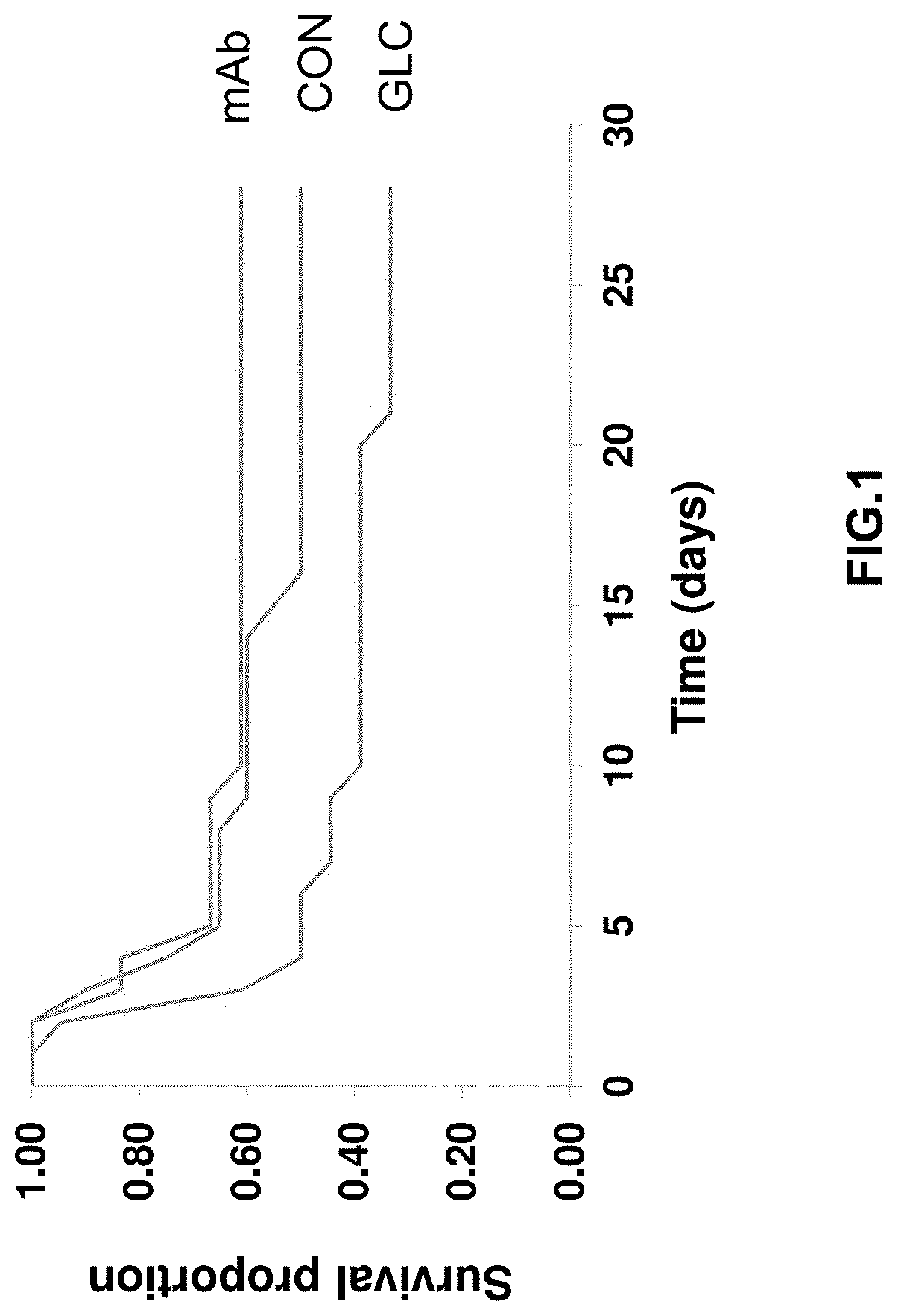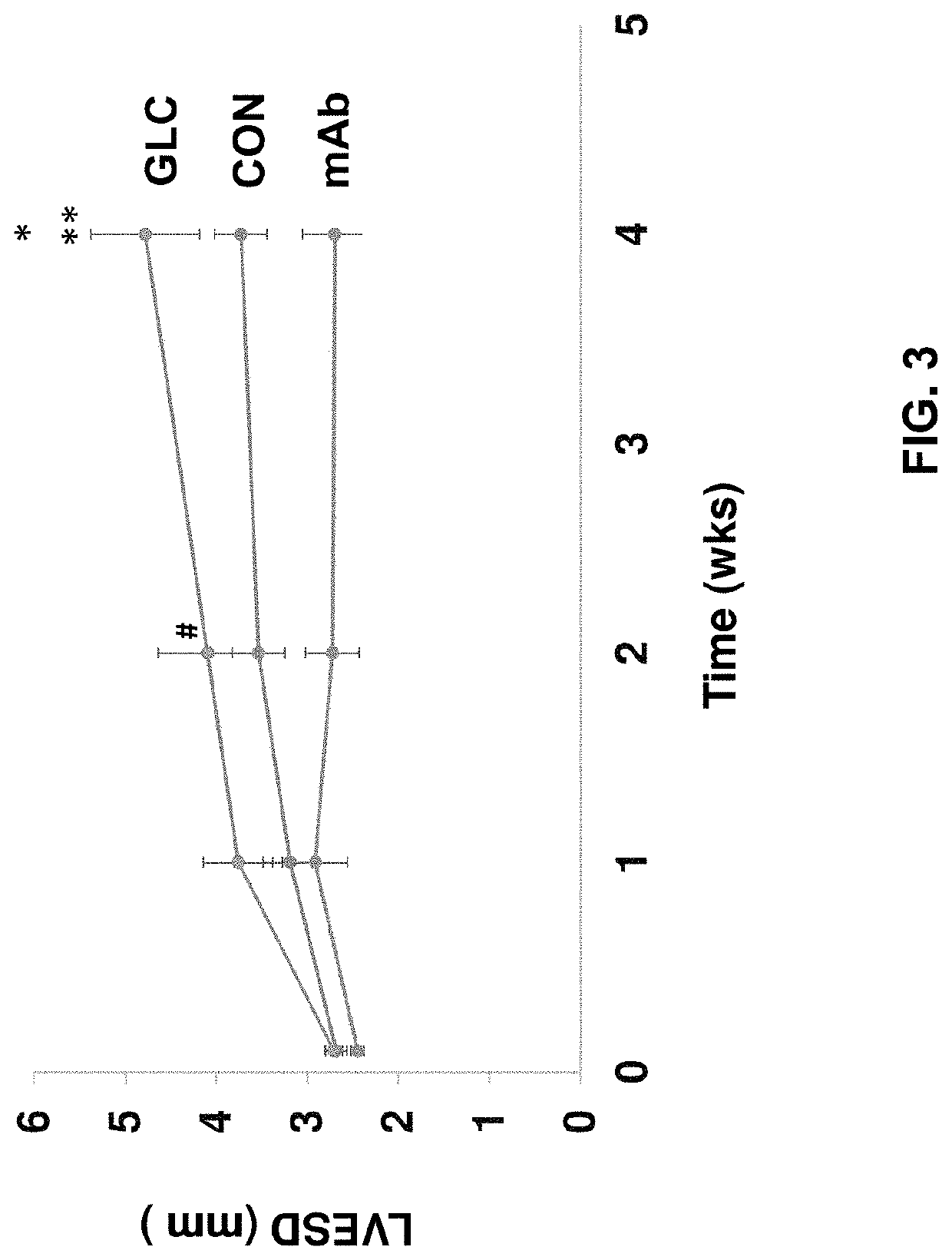Methods for treating heart failure using glucagon receptor antagonistic antibodies
a technology of glucagon receptor and antagonistic antibodies, which is applied in the direction of antibody medical ingredients, drug compositions, peptide/protein ingredients, etc., can solve the problems of heart failure, increased pressure within the ventricle, so as to improve the relaxation of the heart, prevent heart failure, and improve the effect of relaxation
- Summary
- Abstract
- Description
- Claims
- Application Information
AI Technical Summary
Benefits of technology
Problems solved by technology
Method used
Image
Examples
example 1
[0197]In this example, the present inventors evaluated the therapeutic potential of a monoclonal antibody against the glucagon receptor on LV remodeling in post-myocardial infarction heart failure. In this example, the in vivo activity of an anti-GCGR antibody which comprises the heavy chain sequence set forth in SEQ ID NO: 8 and the light chain sequence set forth in SEQ ID NO: 9 (“REMD2.59C”) is evaluated using myocardial infarction induced C57BL / 6 mice.
[0198]Myocardial infarction (MI) was induced in 54 C57BL6 male mice at the age of 8-10 weeks old by occluding the left coronary artery. After MI, mice were randomly divided into three groups. Group 1 was treated with the vehicle PBS as a control (CON, n=18); Group 2 was treated with 7.5 mg / kg REMD2.59C mAb, s.c. at 2 hours and at 14 days post-MI (mAb, n=18); and Group 3 was treated with glucagon (30 ng / kg body weight in 10% gelatin) three times per day for the first six days post MI (GLC, n=18). Sham animals were used as a negative ...
example 2
[0204]In this example, the present inventors evaluated the potential preventive efficacy of a human anti-GCGR antibody on cardiomyopathy induced by diabetes in db / db mice. In this example, the in vivo activity of a human anti-GCGR antibody which comprises the heavy chain sequence set forth in SEQ ID NO: 51 and the light chain sequence set forth in SEQ ID NO: 52 (“REMD477”) was evaluated using C57BL / 6 / db / db male diabetes mice and db / + male control mice.
[0205]In this 18 week study, 30 C57BL6 / db / db diabetes male mice at the age of 8-10 weeks and 18 db / + male mice were randomly divided into four groups. In Group 1, db / + mice (n=9) where treated with the vehicle PBS as a control (hereinafter “db / + (PBS)”); in Group 2, db / + mice (n=9) were treated with REMD477 (hereinafter “db / + (mAb)”); in Group 3, db / db diabetes mice (n=15) where treated with the vehicle PBS as a control (hereinafter “db / db (PBS)”); and in Group 4, db / db mice (n=15) were treated with REMD477 (hereinafter “db / db (mAb)”)....
example 3
[0210]In this example, the in vivo activity of an anti-GCGR antibody which comprises the heavy chain sequence set forth in SEQ ID NO: 8 and the light chain sequence set forth in SEQ ID NO: 9 (“REMD2.59C”) is evaluated for efficacy in a miniature swine myocardial infarct model (Sinclair Research).
[0211]Miniature swine (young adult / female) are given a 7 day acclimation period and randomly divided into two groups. In Group 1, the swine are treated with a single dose of vehicle PBS as a control (CON, n=5) and in Group 2, the swine are treated with a single dose of 7.5 mg / kg REMD2.59C mAb (mAb, n=5). Prior to dose administration, each animal undergoes surgery (ligation of left ascending artery for 10-20 minutes) to create an occlusion and induce myocardial infarction. After 20 minutes, the occlusion is removed and the treatment administered during the reperfusion. The animals are maintained and handled in a stress-free environment post-op.
[0212]Mortality / Morbidity observations are made t...
PUM
 Login to View More
Login to View More Abstract
Description
Claims
Application Information
 Login to View More
Login to View More - R&D
- Intellectual Property
- Life Sciences
- Materials
- Tech Scout
- Unparalleled Data Quality
- Higher Quality Content
- 60% Fewer Hallucinations
Browse by: Latest US Patents, China's latest patents, Technical Efficacy Thesaurus, Application Domain, Technology Topic, Popular Technical Reports.
© 2025 PatSnap. All rights reserved.Legal|Privacy policy|Modern Slavery Act Transparency Statement|Sitemap|About US| Contact US: help@patsnap.com



